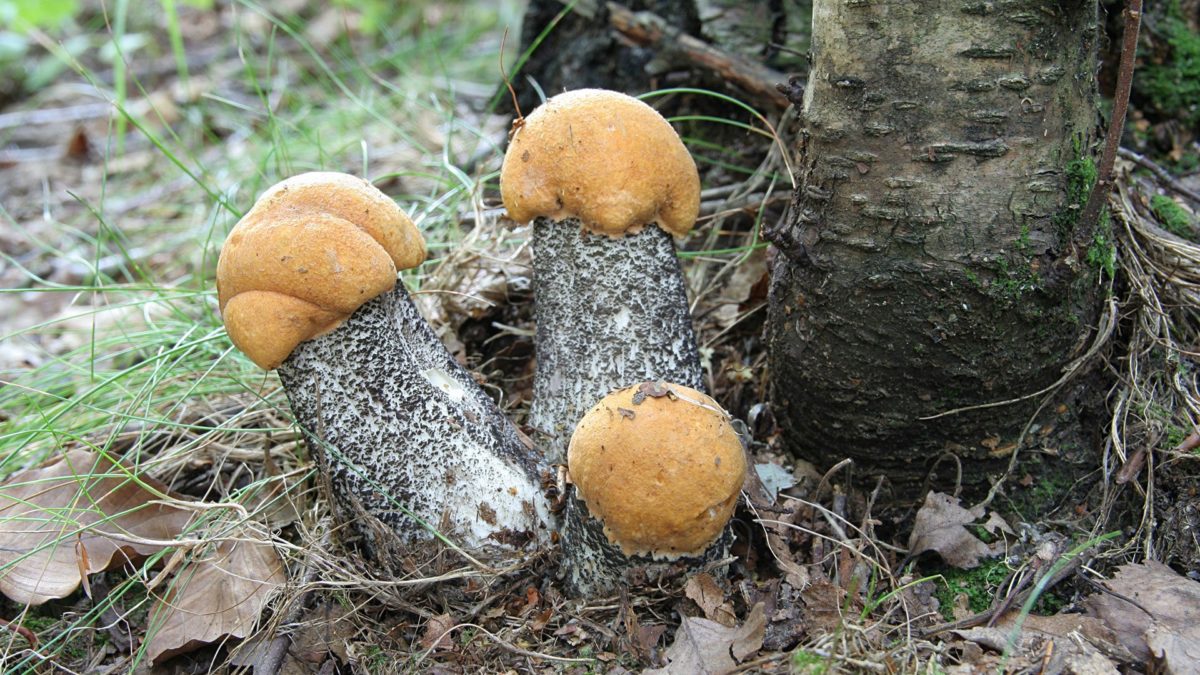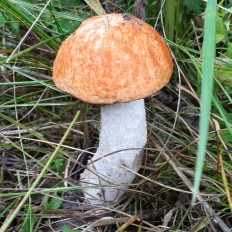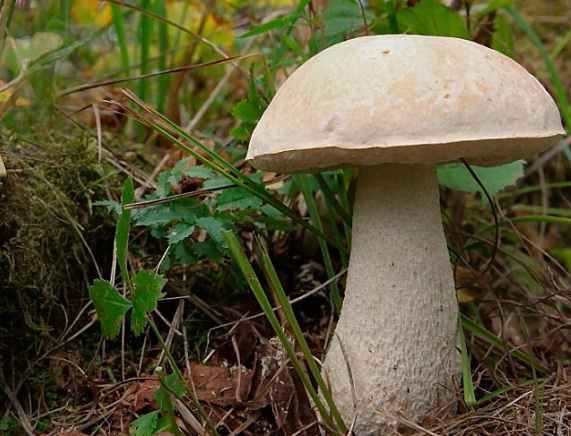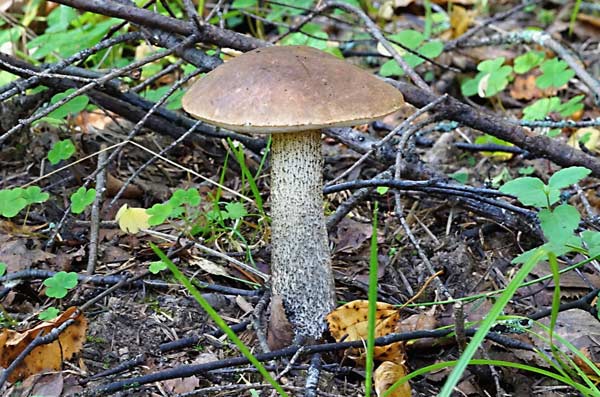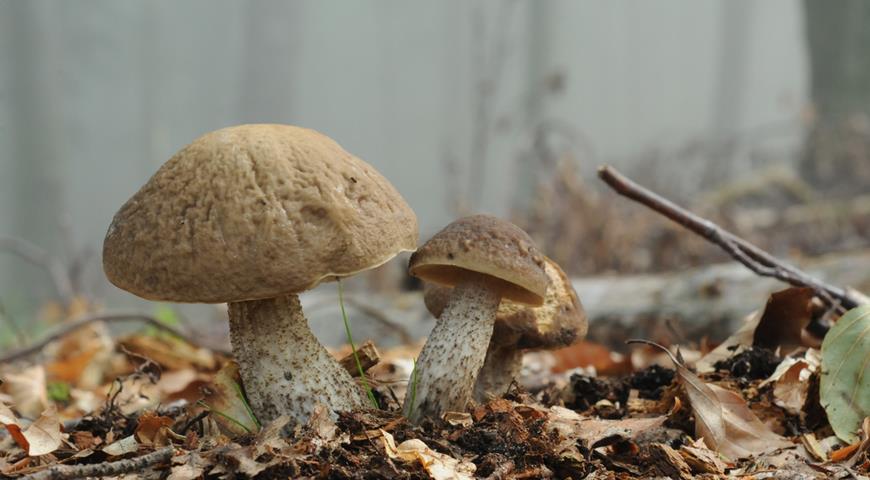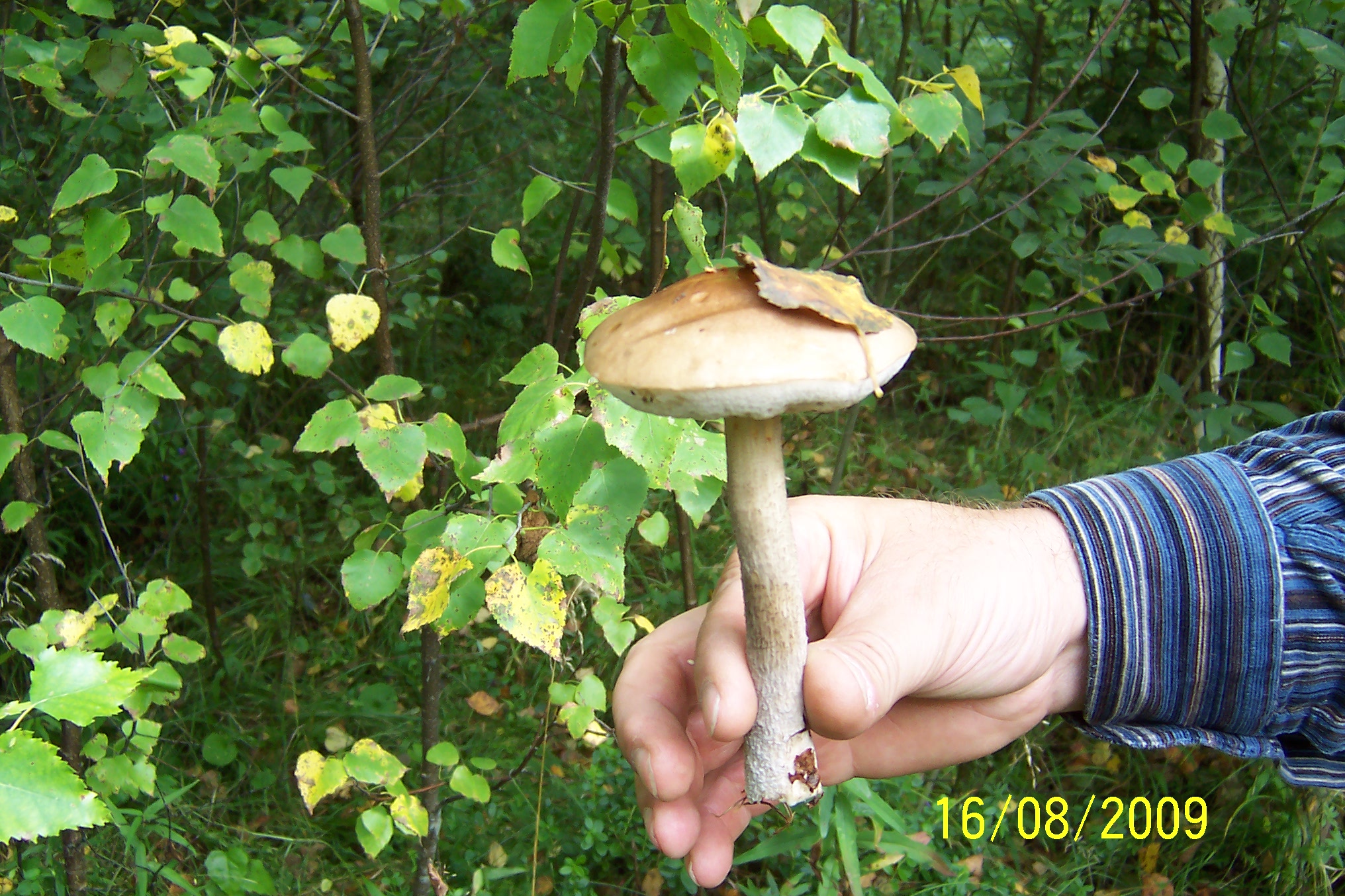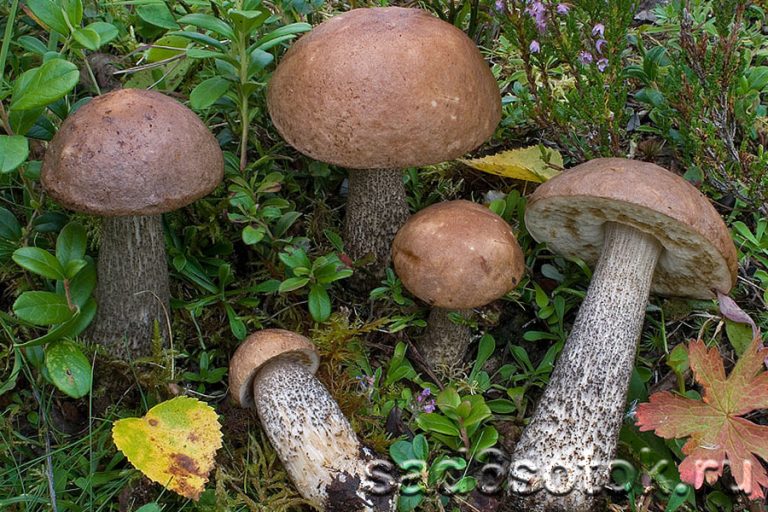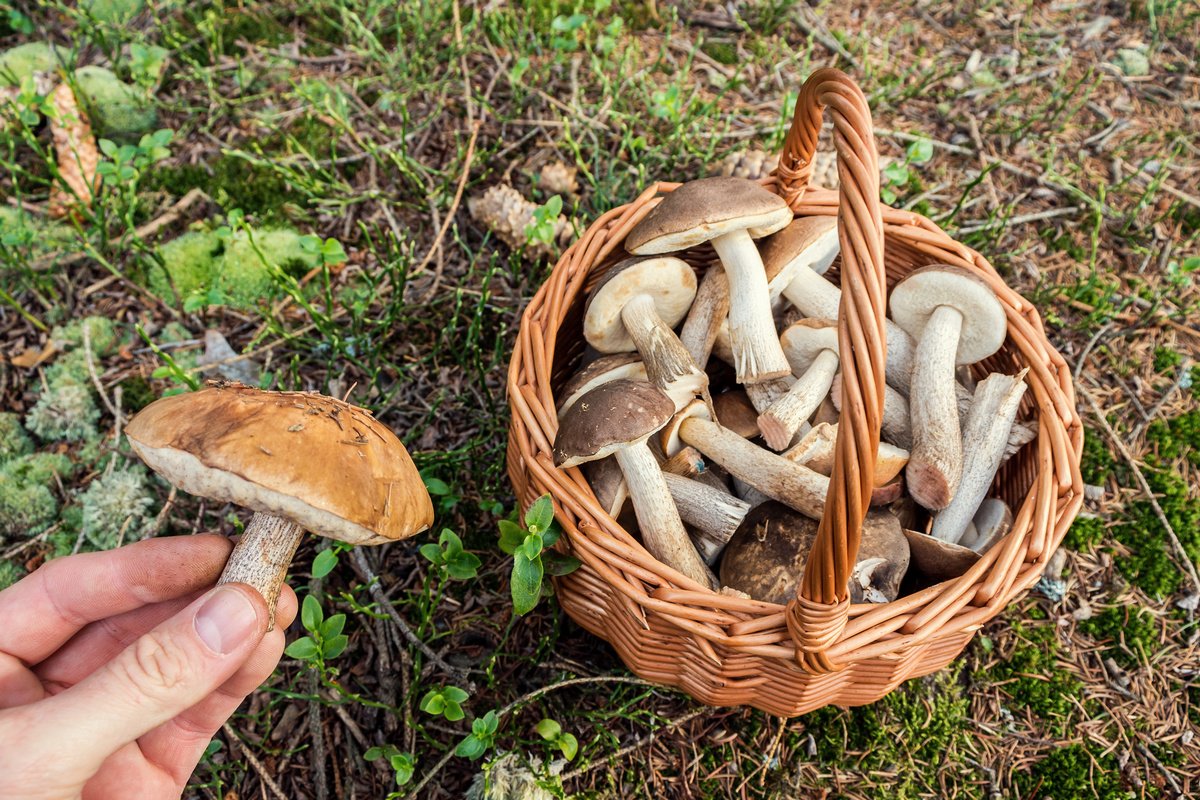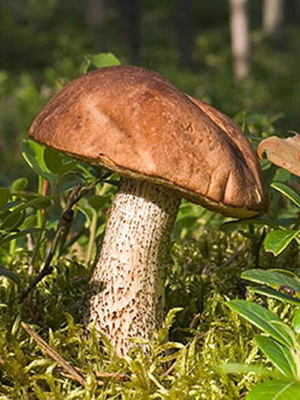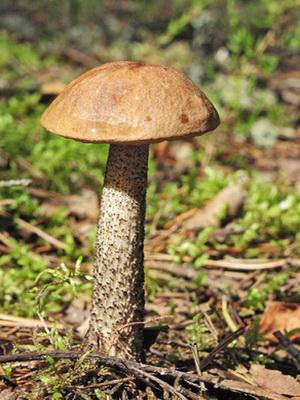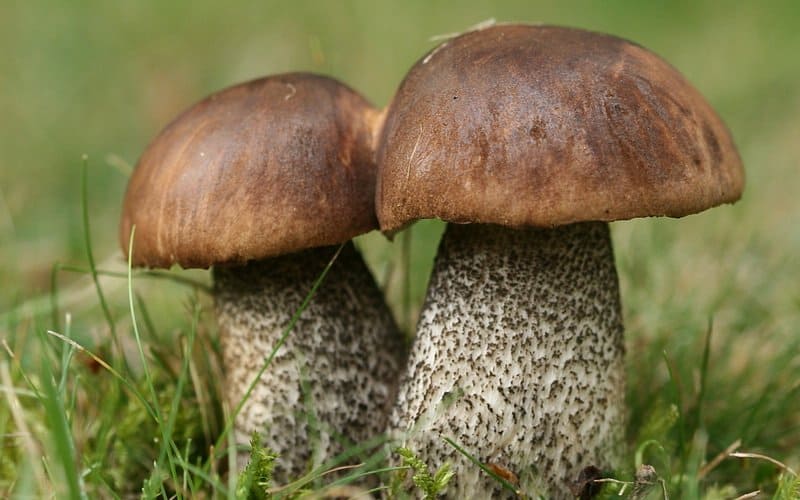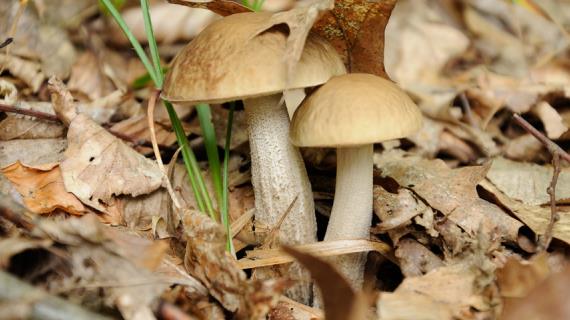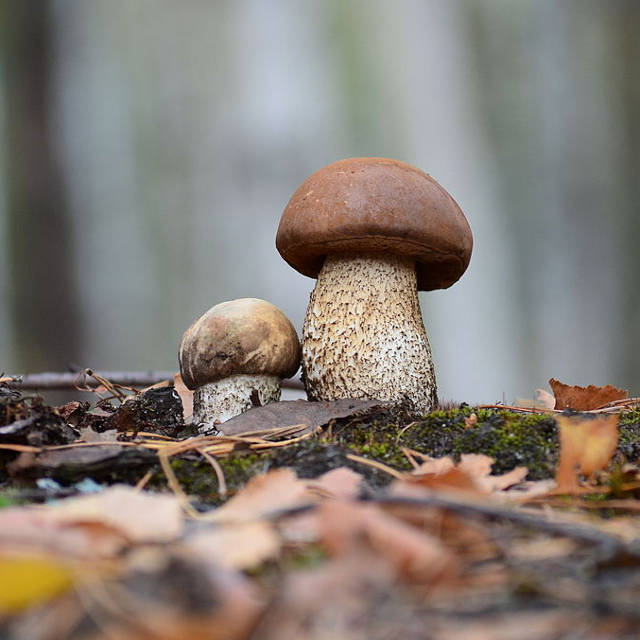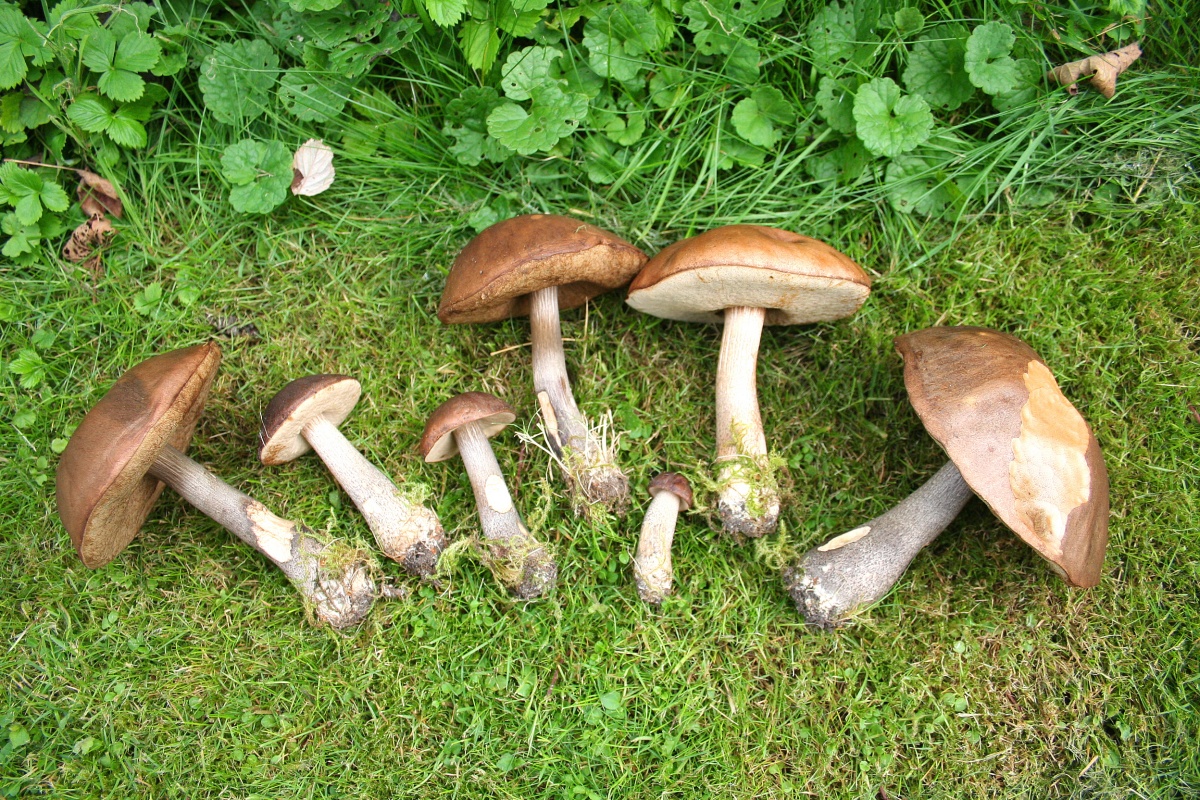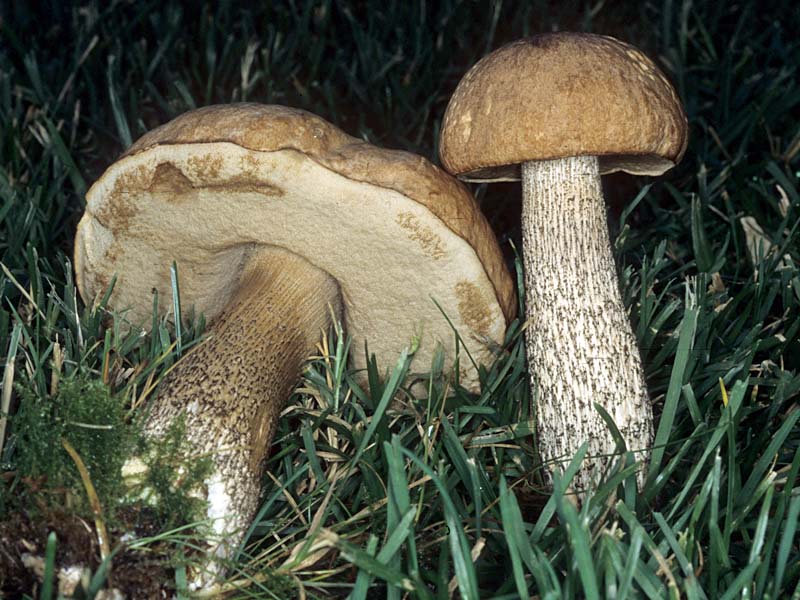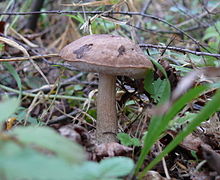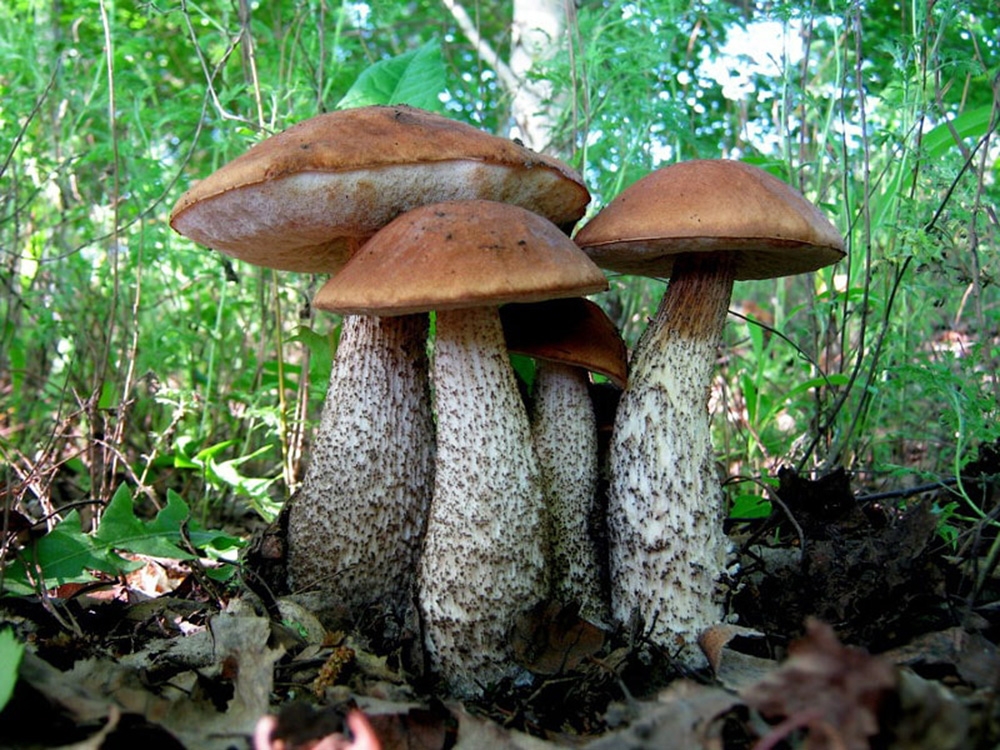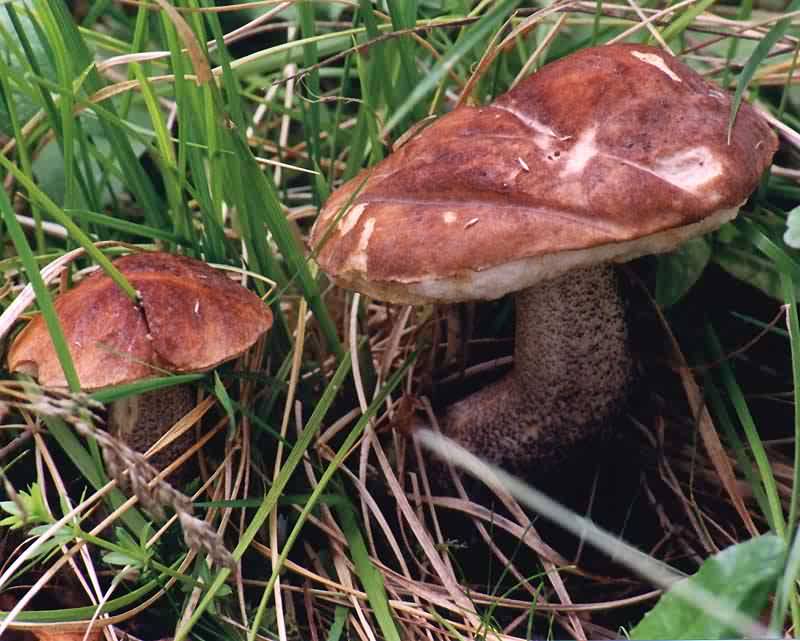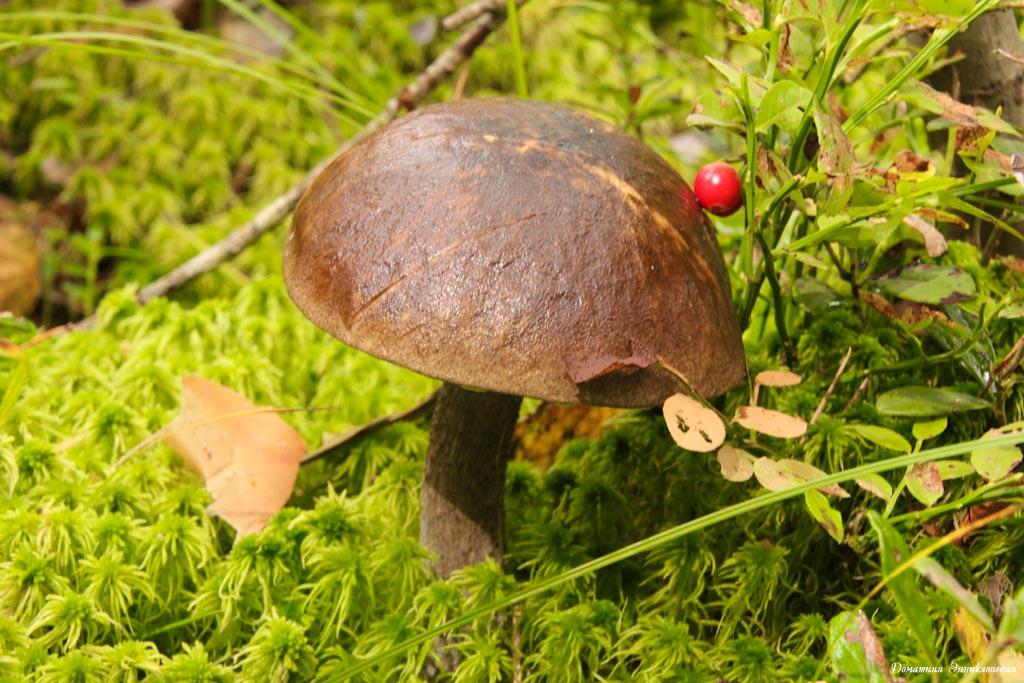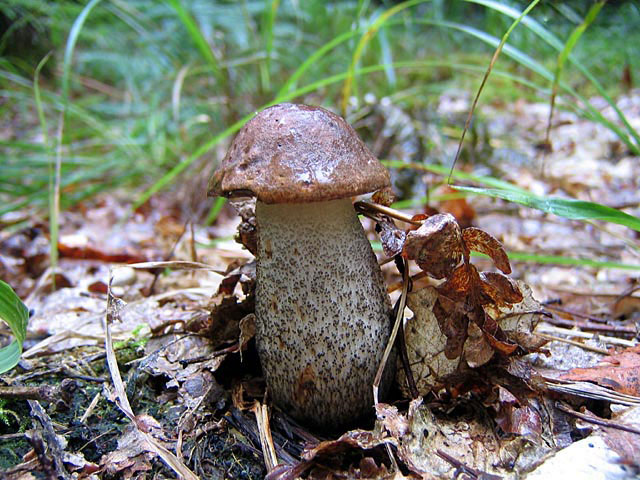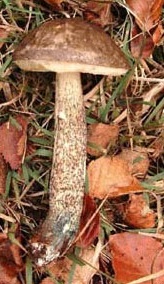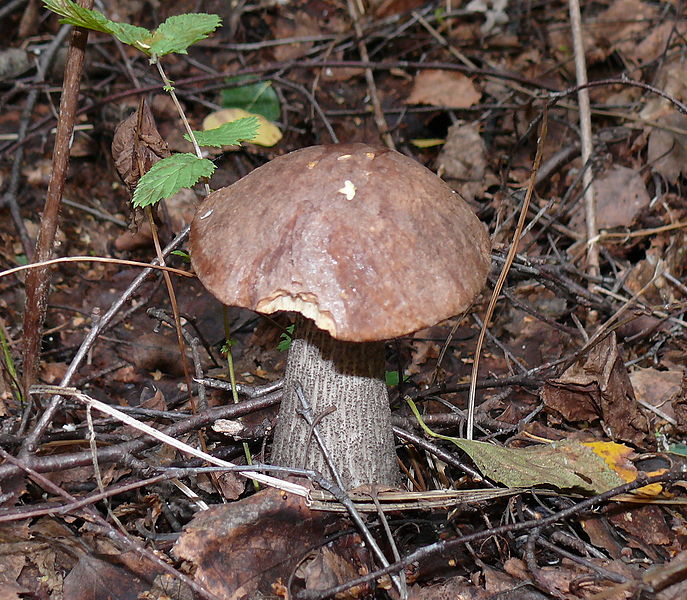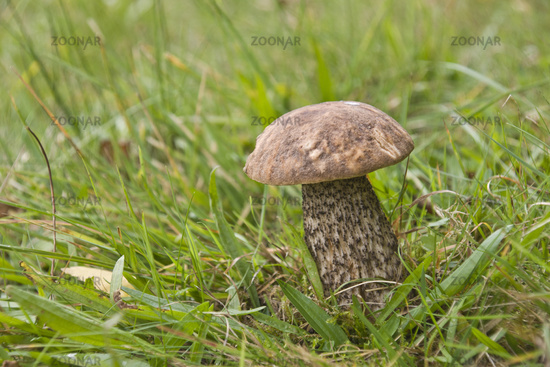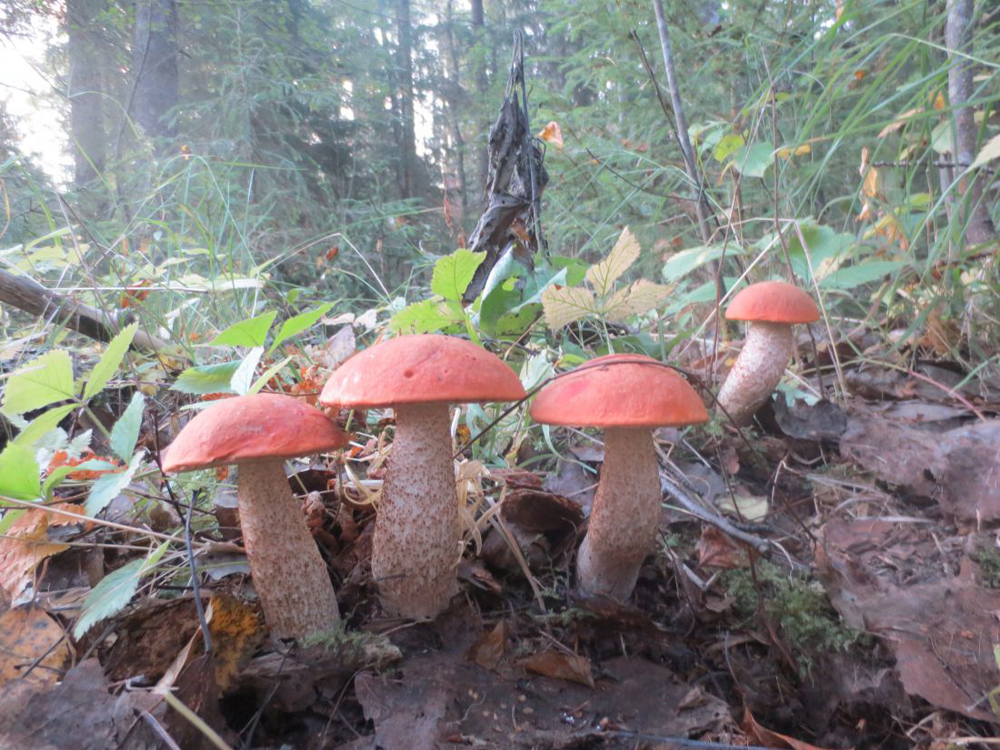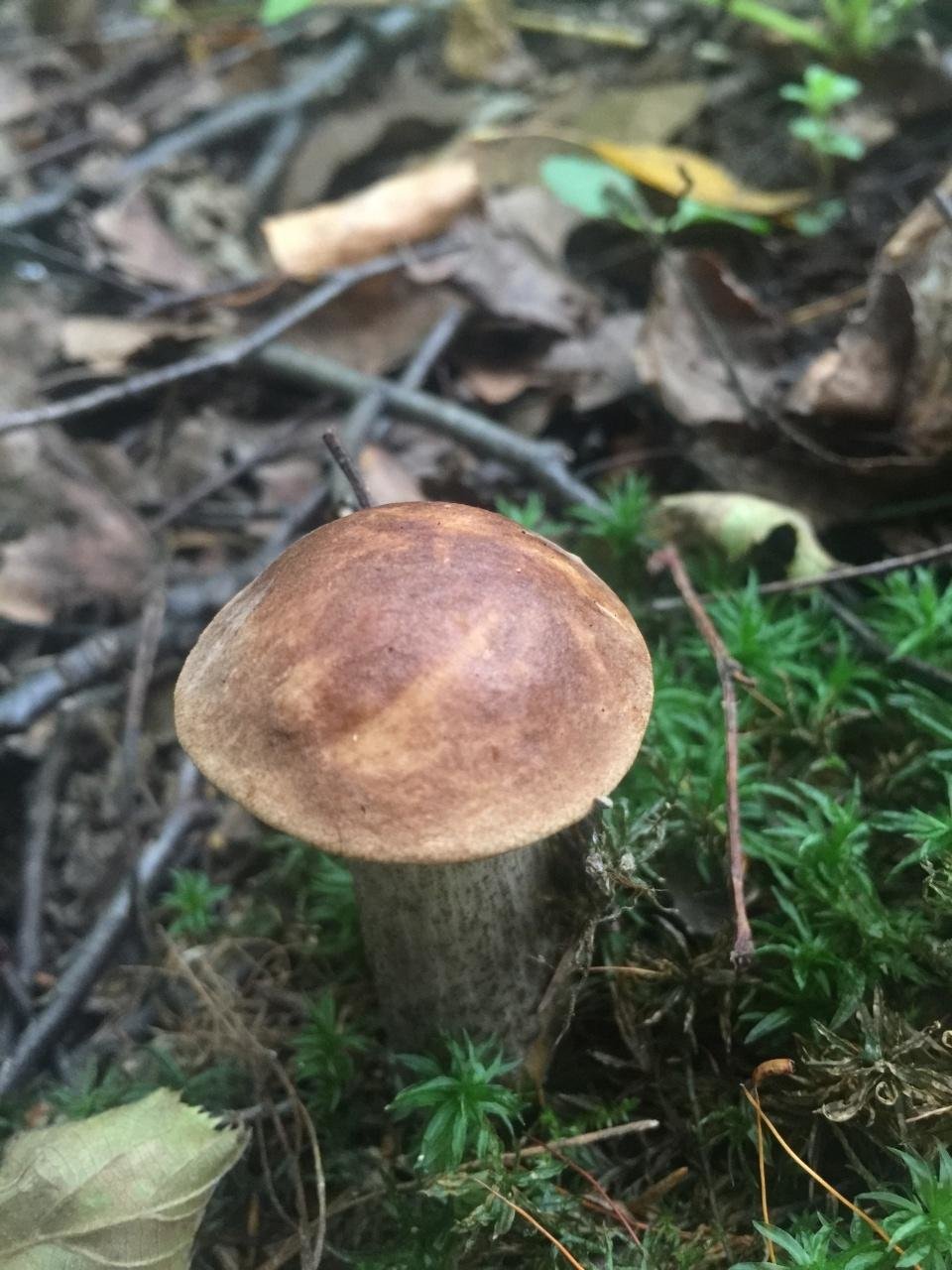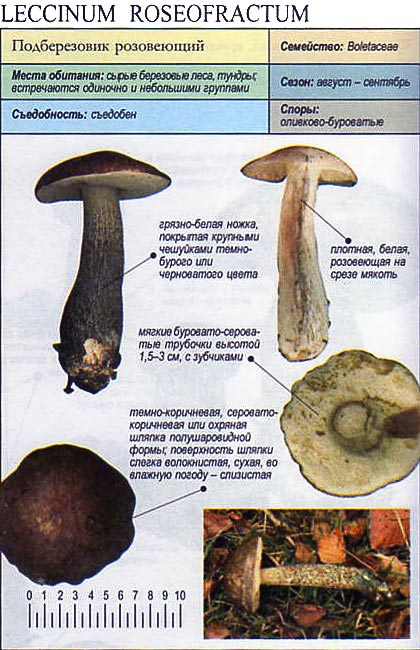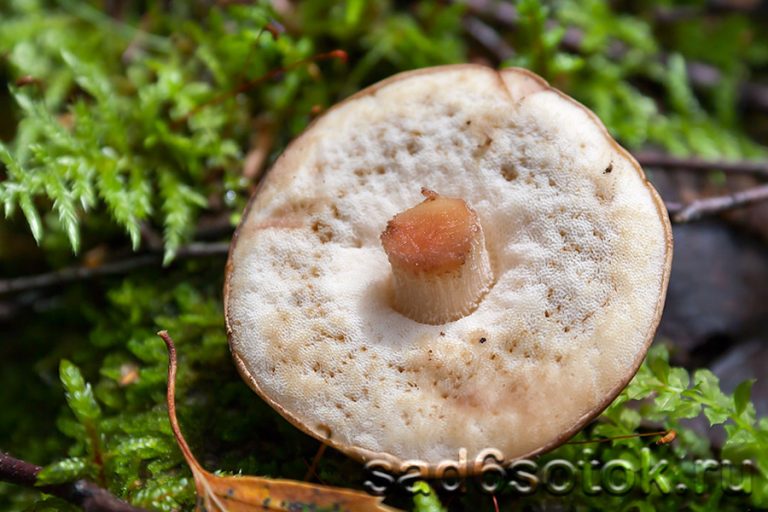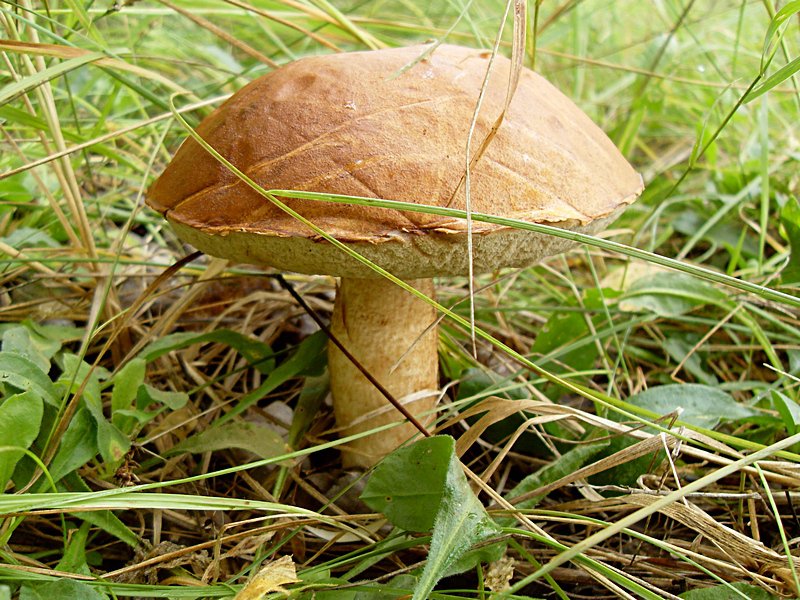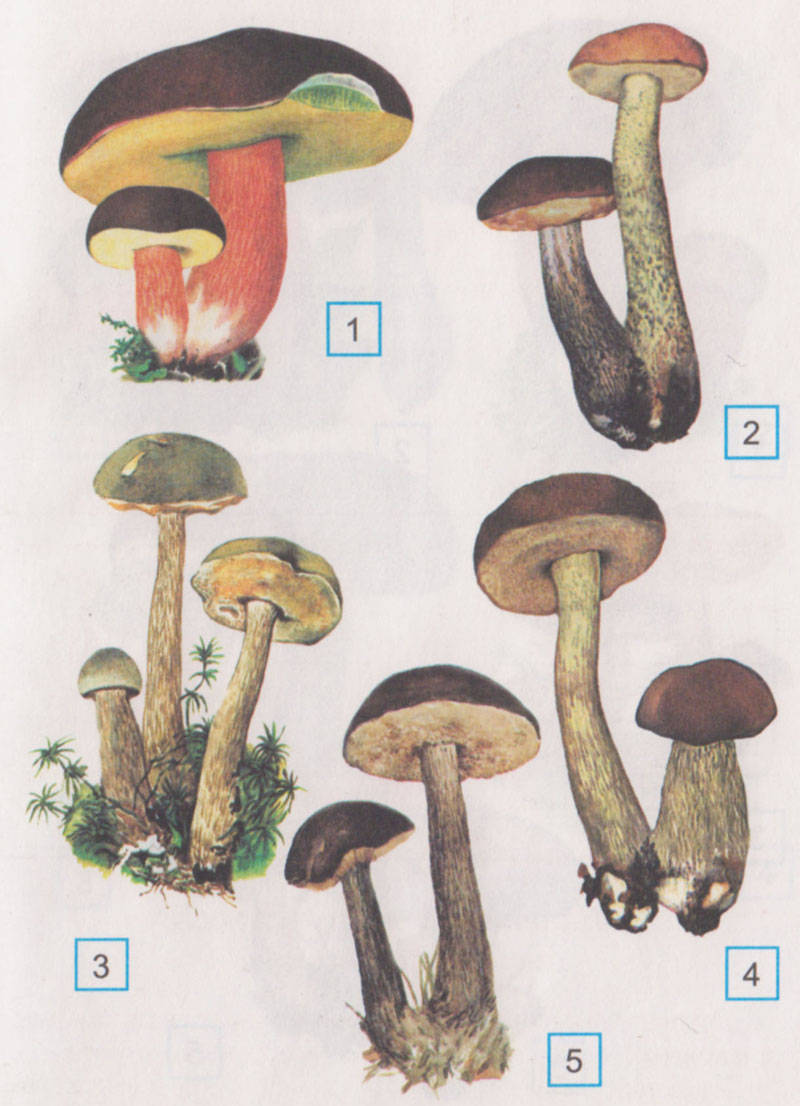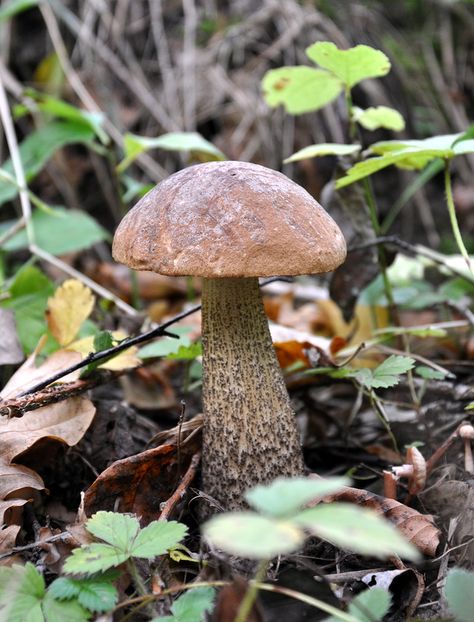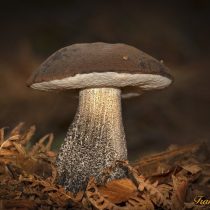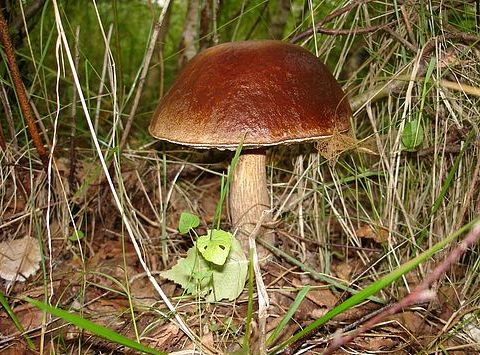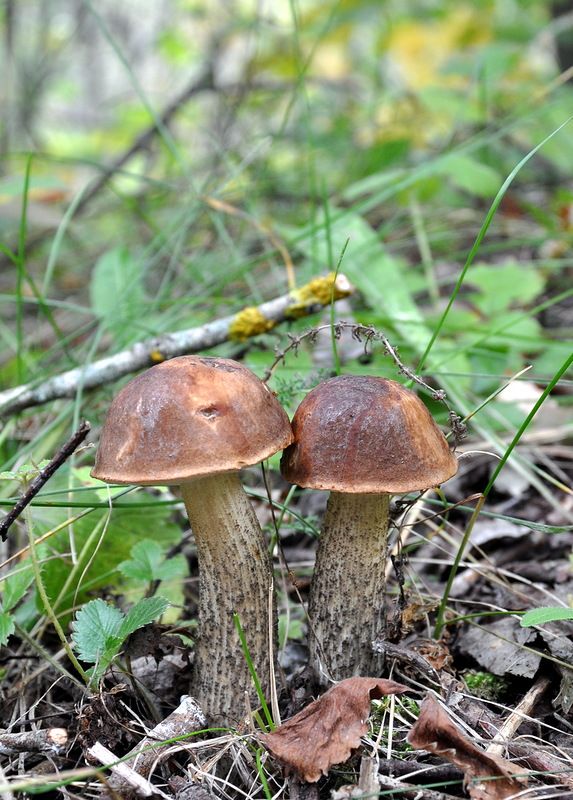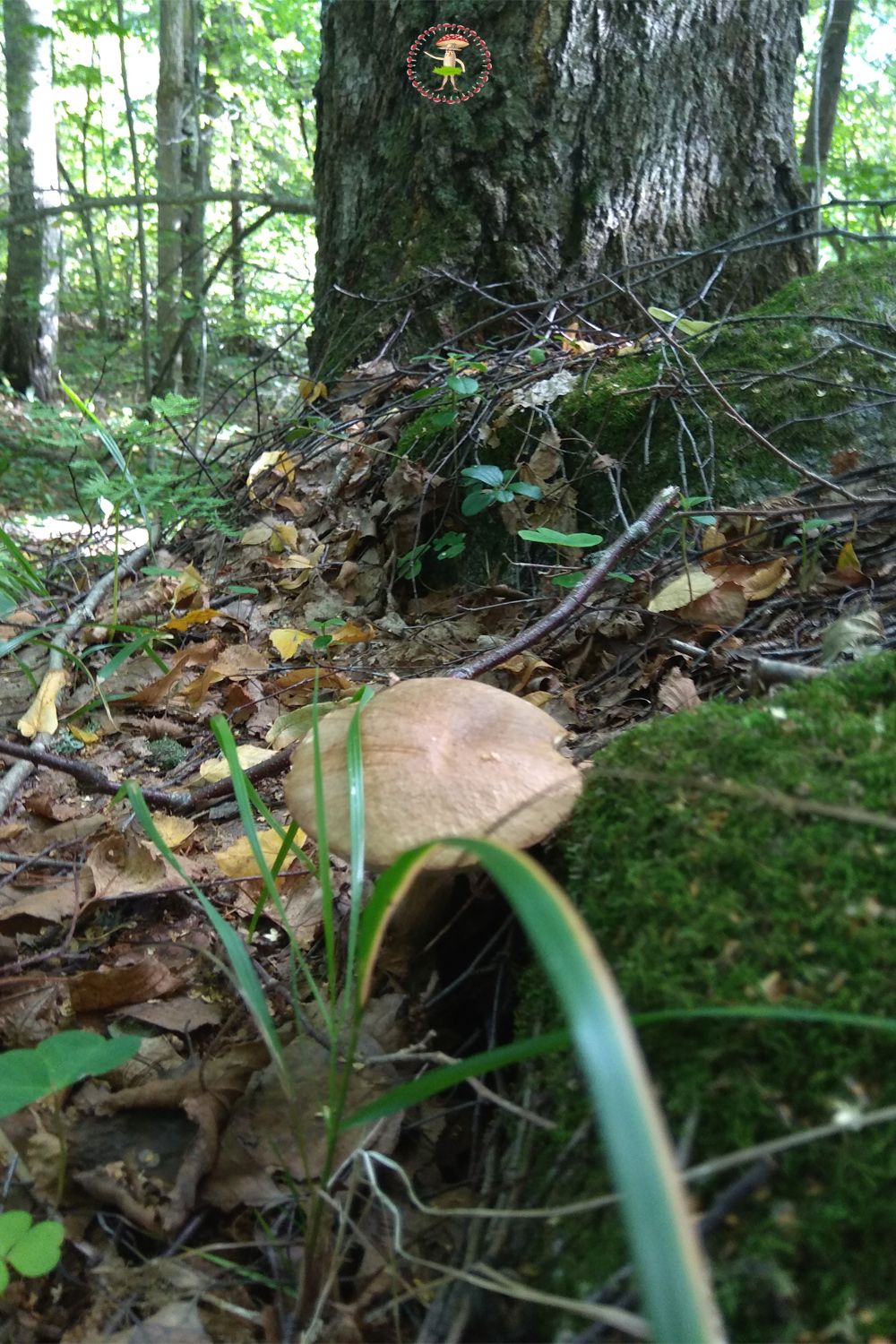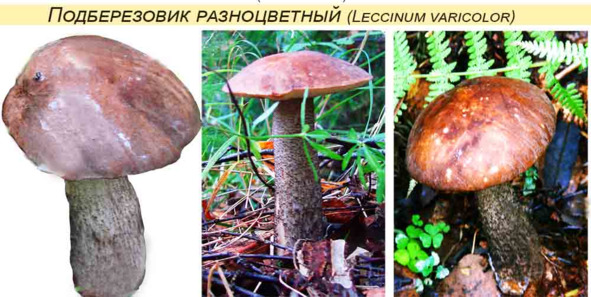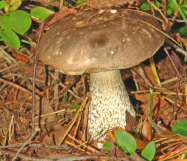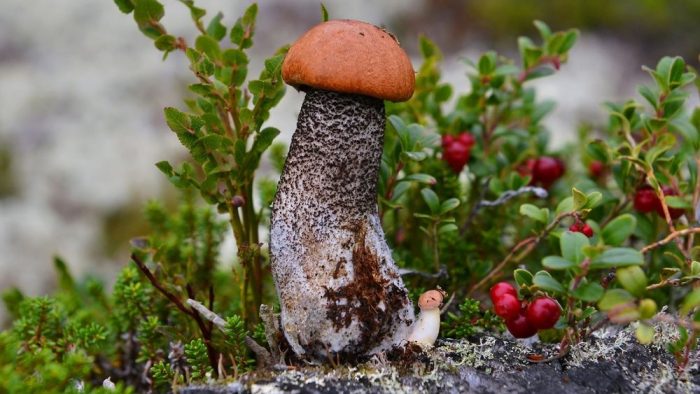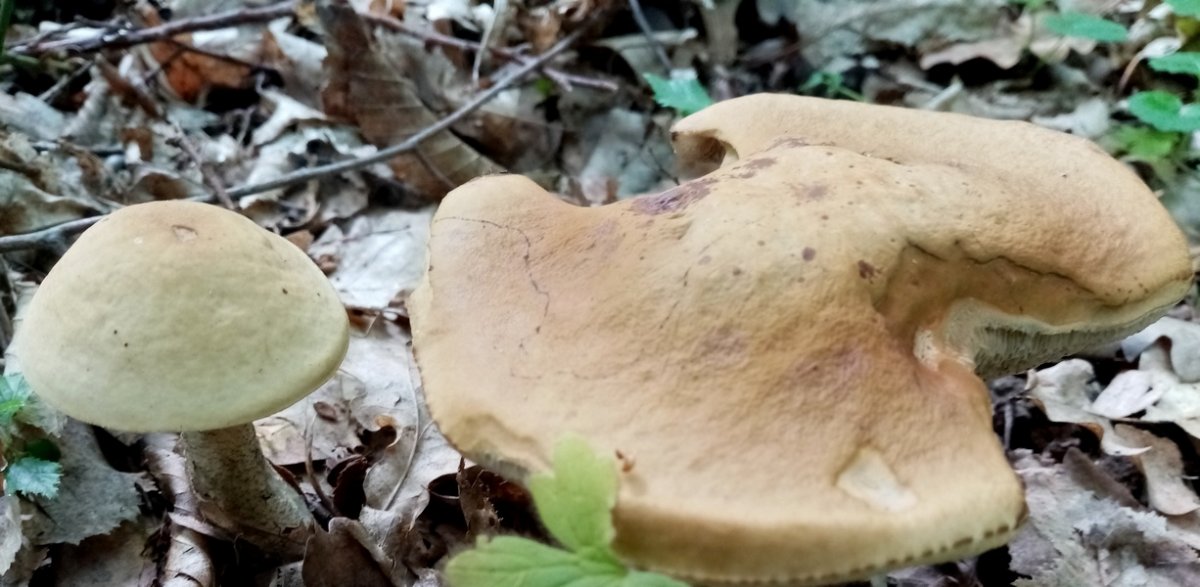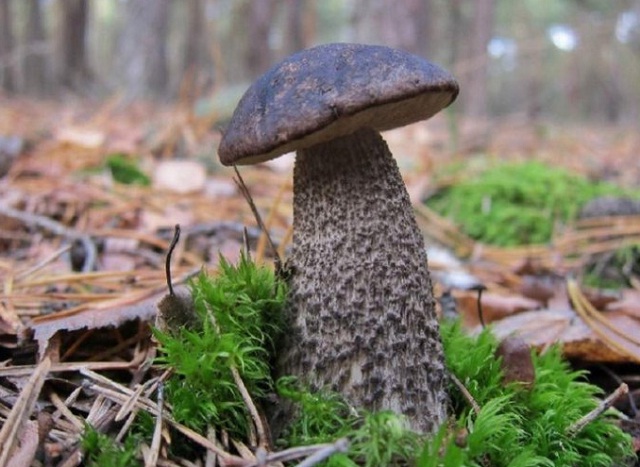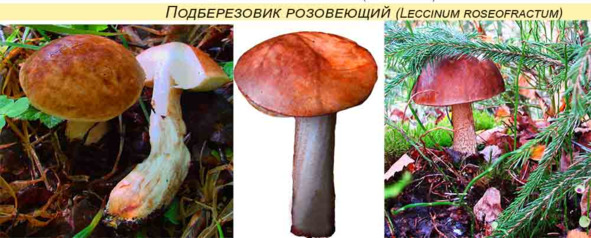What should not be confused with?
It’s safe to confuse with mushrooms, Polish mushrooms, porcini and even some aspen mushrooms: all this will easily get along in a brazier, enriching the taste.
But careless placement in a basket of a bile mushroom can ruin not only a meal, but also greatly harm health. The taste of the mushroom is disgustingly bitter and only intensifies when cooked
In addition to the bitterness itself, the toxins of the fungus disrupt the functioning of the liver.
In a young bile fungus, the tubular layer is white and at this moment it is easiest to confuse it with birch and white. Later, the tubular layer clearly turns pink, when pressed, it turns brown, and here it is already easier to distinguish it. Scales on the leg are a striking distinctive feature - the bile fungus, unlike the brown birch, does not have them. But there is a mesh on the leg, because of which it is confused with a porcini mushroom.
Unlike white, bitter (Tylopilus felleus) - another name for the gall fungus - turns pink at the break. And this mushroom is practically never wormy - even the larvae of mushroom mosquitoes categorically refuse to eat such bitterness. Bitter potato grows from June to autumn everywhere, so you need to be careful.
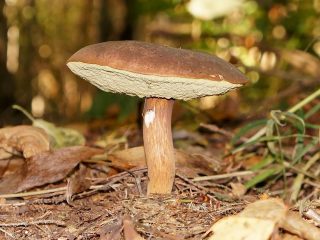 Polish mushroom (Imleria badia)
Polish mushroom (Imleria badia)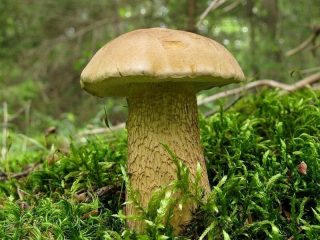 Gall mushroom, or Gorchak (Tylopilus felleus). tursar
Gall mushroom, or Gorchak (Tylopilus felleus). tursar
Common boletus (Leccinum scabrum)
- Other names for the mushroom:
- Birch
- Obabok
- Beryozovik
Synonyms:
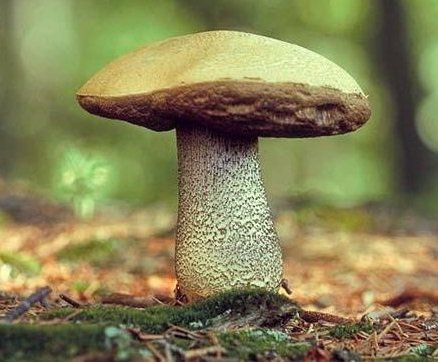
Hat:
In the brown birch tree, the cap can vary from light gray to dark brown (the color obviously depends on the growing conditions and the type of tree with which the mycorrhiza is formed). Form - semi-spherical, then pillow-shaped, naked or thin-clotted, up to 15 cm in diameter, slightly slimy in wet weather. The pulp is white, does not change color or slightly turns pink, with a pleasant "mushroom" smell and taste. In old mushrooms, the pulp becomes very spongy, watery.
Spore-bearing layer:
White, then dirty gray, the tubes are long, often eaten by someone, easily separated from the cap.
Spore powder:
Olive brown.
Leg:
The length of the leg of the common birch tree can reach 15 cm, diameter up to 3 cm, solid. The shape of the stem is cylindrical, slightly widened at the bottom, gray-whitish, covered with dark longitudinal scales. The pulp of the leg with age becomes woody-fibrous, tough.
Spreading:
Common boletus (Leccinum scabrum) grows from early summer to late autumn in deciduous (preferably birch) and mixed forests, in some years it is very abundant. Sometimes found in surprising quantities in spruce plantings interspersed with birch. It gives good yields in very young birch forests, appearing there almost the first among commercial mushrooms.
Similar species:
The genus Common birch tree has many species and subspecies, many of them are very similar to each other. The main difference between boletus boletus (a group of species united under this name) and boletus boletus (another group of species) is that boletus boletus turn blue at the break, while boletus boletus does not. Thus, it is easy to distinguish between them, although the meaning of such an arbitrary classification is not entirely clear to me. Moreover, in fact, there are actually enough among the "boletus" and species that change color - for example, pink boletus (Leccinum oxydabile). In general, the further into the forest, the more varieties of paints.
It is more useful to distinguish the common birch (and all decent mushrooms) from the gall mushroom. The latter, in addition to the disgusting taste, is distinguished by the pinkish color of the tubes, a special "greasy" texture of the pulp, a peculiar mesh pattern on the leg (the pattern is like that of a porcini mushroom, only dark), a tuberous leg, unusual places of growth (around stumps, near ditches, in dark conifers forests, etc.). In practice, confusing these mushrooms is not dangerous, but offensive.
Edibility:
Common boletus - Normal edible mushroom. Some (Western) sources indicate that only the caps are edible, and the legs are supposedly too hard. Absurd! The prepared hats are just different with a nauseating gelatinous consistency, while the legs always remain strong, collected. The only thing that all reasonable people agree on is that the tubular layer of old mushrooms must be removed. (And, ideally, take it back to the forest.)
Author's notes: Despite the seeming routine, the common boletus is a rather mysterious mushroom. First, fruiting. For several years it can grow in Homeric quantities everywhere and everywhere. In the early 90s, boletus was, without exaggeration, the most widespread mushroom in the Naro-Fominsk region. He was loaded with buckets, troughs, trunks. And in one year he disappeared, and he still does not exist. There were enough whites as they are (despite the crowds of greedy summer residents), and the boletus has disappeared. From time to time only monstrous freaks come across: small, thin, twisted.
In the summer of 2002, for obvious reasons, there were no mushroom pickers at all, and what do you think? from time to time we came across quite decent boletus boletus. Something will happen next time, I thought.
And the next time was not long in coming. The summer and autumn of 2003 turned out to be so fruitful that all speculation about the degeneration of the boletus can be safely sent to the dump of opinions. Common boletus and went in June and walked and walked and walked without interruption until the beginning of October. The field, overgrown with young birch trees, was completely trampled by mushroom pickers - but without a bag of these common brown birch trees, not a single good person returned. The forest edges were cluttered with stools. Three times in a row (without missing a day) I could not get to the place where I expected to meet a black lump, my character let me down: I immediately grabbed all the young and strong Common birch trees that I just saw, and after 100 meters my hike ended: it's banal there was no container. I am sure that for many years the 2003 season will be remembered as a fairy tale, but then the sensations were different. It seemed that literally in front of my eyes the value of the boletus was being devalued.
How to cook
The pink boletus has a dense, fleshy pulp, a rich, rich mushroom aroma and a sweetish, delicate taste. It showed itself well in boiled, fried, stewed, baked form. It can even be eaten raw. Therefore, there are a lot of recipes for making pink boletus. Often serves as a filling for pies, pizza, rolls, etc.
However, it should be borne in mind that the structure of the pulp of the cap and leg is different. Legs, being more rigid, require a longer heat treatment, so they are more suitable for making soups, sauces, main courses. They go well with vegetables, meat.
The disadvantage of pink boletus is that after heat treatment it turns black. This is not a sign of spoilage and does not affect the quality of the finished dish. Taste and aroma properties remain unchanged.
Black boletus (blackened boletus): description and photo
| Name: | Blackening obbok |
| Latin name: | Leccinellum crocipodium |
| Type of: | Edible |
| Synonyms: | Leccinum nigrescens |
| Systematics: |
|
Boletus or blackening boletus (Leccinum nigrescens or Leccinellum crocipodium) is a mushroom of the Boletovye family. This is a typical representative of the genus Leccinellum with an average nutritional value.
Black boletus of medium-late fruiting
Where the blackening mushroom grows
Blackening obobok is a thermophilic species. The distribution area in Russia is the North Caucasus.It grows in any type of forest if it contains beech and oak, with the root system of which it forms mycorrhiza. Fruiting from late June to mid-September in dry, warm weather. The main accumulation of mushrooms is in moderately open, moist areas. There are solitary specimens or small compact groups. The species gives preference to acidic soils.
What does blackening look like
This is a medium-sized mushroom - up to 15 cm high with the same cap diameter. The color of the fruit body of young specimens is of a uniform bright yellow color, mature ones with a light brown tint.
Photo and external characteristics of the blackening trim:
- At the beginning of the growing season, the cap is in the form of a hemisphere, then gradually opens, becomes cushion-shaped with smooth blunt edges.
- The surface is even, often monochromatic, the protective layer is velvety with cracks of various shapes and sizes.
- The lower part of the cap is tubular, dense, the cells are small, the thickness of the spore-bearing layer is up to 3 cm, it has a clear notched border near the stem.
- The color is bright lemon at the beginning of growth, then it becomes darker.
- The leg is clavate, thickened near the ground. The structure is fibrous one-piece. The surface at the base is finely reticulated, closer to the cap it is scaly, pale yellow in color.
Radial stripes on the surface become wider towards the edge of the cap
The pulp is yellow in color, with a soft consistency, it can turn dark red or purple on the cut, then black. This feature gave the name to the species.
Is it possible to eat blackening curbs
The species is edible, in terms of nutritional value, it belongs to the third group. Fruit bodies do not require boiling or soaking before use. The taste and smell are weak.
Benefits and harm to the body
The fruit bodies have a high protein content, but with a low level of fats and carbohydrates. Overweight people include blackening in the diet. Fiber in the fruit bodies promotes the growth of bifidobacteria in the intestine, thereby improving the functioning of the gastrointestinal tract. Useful properties of fruit bodies:
- strengthen the immune system;
- stimulate the brain;
- calm the nervous system;
- help get rid of insomnia;
- restore liver cells;
- have antibiotic properties;
- destroy pathogenic microorganisms;
- promote tissue regeneration;
- participate in the process of hematopoiesis;
- lower cholesterol.
Mushroom dishes are contraindicated for use with exacerbation of chronic gastritis, women during lactation, small children.
False doubles
Outwardly, it looks like a blackening gall mushroom. It is distributed in the central and European part. The double is inedible due to its bitter taste, and is also poisonous. The color is light or dark brown with a pronounced coarse-mesh surface on the stem.
The pulp turns dark pink at the cut site
Use
Fruit bodies are universal in use: they are fried, boiled in soup, stewed or baked with vegetables and meat. Used for winter harvesting, pickled or salted. The obobok is dried, then the finished product will be dark in color. Good for freezing raw, boiled or fried.
Conclusion
Blackening gum is an edible mushroom, belongs to the third category. Fruiting bodies with a weak taste and indistinct odor. Fruiting of the species is abundant - from June to September. Common in warm climates. A distinctive feature of the stump is that the pulp at the cut site becomes pink.
Species diversity and description
Boletus is a collective name for a number of mushrooms of the genus Leccinum (Leccinum). Excellent growing conditions have led to the fact that the boletus species have minor external differences.
It is important to know what a particular boletus looks like in order to be able to distinguish it from other mushrooms.
Marsh (Leccinum holopus)
Marsh boletus, or white, got its name from the place of growth. This mushroom is noticeably different from other boletus mushrooms. The hat is on average 3 to 10 cm in diameter, but can reach 16 cm.The convex cushion shape is characteristic only of young mushrooms; with age, it becomes flat. The surface is smooth, sometimes wrinkled. The hat is painted in a color uncharacteristic for this group: whitish-cream or grayish with a bluish or greenish tint.
The leg is thin (1-3 cm), elongated (from 5 to 15 cm), whitish or grayish in color, covered with scales of the same color. The scales turn brown only after aging, drying of the fungus; it is better not to collect such specimens.
The tubular layer is first white, then a dirty grayish color. The pulp is watery, white with a slight greenish tinge; denser in the leg, at the base its color becomes bluish-greenish. Does not change color upon contact with air.
Harsh (Leccinum duriusculum)
The cap is rarely more than 15 cm. The shape is hemispherical, later - pillow-shaped, convex. In young mushrooms, the skin is silky, even pubescent, then it becomes smooth; becomes slimy in rainy weather. Depending on the conditions, the color can vary from light gray-brown, sometimes with a purple tint, to brownish-red or ocher-brown.
The tubules are light, creamy, then yellowish or grayish. Olive brown marks remain when pressed.
The stem is cylindrical, rarely pointed at the base; covered with brownish scales that form a reticular pattern. Colored unevenly: cream on top, brownish below. The flesh in the cap is dense, white, reddens at the cut. In the leg, it is denser, harsh; yellowish-green at base, light above. The smell is weak.
Gray (hornbeam) (Leccinum carpini)
This mushroom is most similar to the common boletus. The cap is hemispherical, eventually cushion-shaped, up to 8 cm in diameter, rarely up to 14 cm; in young specimens, the edge is bent, straightens with age. The surface is dry, velvety, slightly grainy; painted in brownish-gray tones. In rainy weather, the color darkens to olive brown.
The leg is cylindrical, rather thin (up to 4 cm), long (from 5 to 13 cm); in the lower part it has a clavate thickening. The color is uneven: brownish at first, grayish closer to the cap. Its entire surface is covered with whitish scales, which turn yellow over time, then acquire a dark brown hue.
The tubular layer is watery, freely separates from the pulp, whitish or sandy-gray in color; a notch is visible in the area of contact with the leg. The pulp is white: soft in the cap and fibrous in the stem, it becomes harsh in old mushrooms. In air, it changes color first to pinkish-purple, then darkens almost to black.
Black (Leccinum scabrum)
Black boletus has a small (5-9 cm) dark brown or almost black cap. The skin cracks with age, partially exposing the flesh. The leg is proportionate, cylindrical, white, covered with small dark scales. The tubules are brownish gray. The pulp is white, darkens at the break.
Turning pink (Leccinum roseofractum)
The pink boletus has a convex, with age, pillow-shaped cap of medium size (up to 15 cm). The skin is gray-brown, pinkish-brown, may be darker, up to dark brown; dry.
Stem thin, long, cylindrical, with a thickening at the base in young specimens; sometimes bends, white with brownish scales, which become almost black with age. The tubular layer is light, becomes dirty gray with age. The pulp is firm. On the cut, this boletus turns pink.
Contraindications
Whatever the useful product and whatever gastronomic qualities it may have, before use it is always necessary to take into account not only the benefits, but also the contraindications of the multi-colored boletus
With caution, the mushroom is recommended to be used for diseases:
- stomach,
- liver and gallbladder,
- kidneys.
And in the exacerbation stage, it is better to completely exclude dishes with multi-colored boletus from the diet. In any case, it will not be superfluous to have a preliminary consultation with a doctor you trust.
Also, multi-colored boletus can bring harm to health:
- women during lactation,
- the presence of allergies to mushrooms.
If you are prone to allergic reactions, you need to be careful and include the boletus in the diet gradually, starting with a small amount. Since mushrooms are a rather heavy product for the digestive system, they are not recommended to be given to children under 7 years old.
Since mushrooms are a rather heavy product for the digestive system, they are not recommended to be given to children under 7 years old.
Literature:
Lesso T. Mushrooms. Determinant.
Definitioner
- Basidia (Basidia)
-
Lat. Basidia. A specialized structure of sexual reproduction in fungi, inherent only in Basidiomycetes. Basidia are terminal (end) elements of hyphae of various shapes and sizes, on which spores develop exogenously (outside).
Basidia are diverse in structure and method of attachment to hyphae.
According to the position relative to the axis of the hypha, to which they are attached, three types of basidia are distinguished:
Apical basidia are formed from the terminal cell of the hypha and are located parallel to its axis.
Pleurobasidia are formed from lateral processes and are located perpendicular to the axis of the hypha, which continues to grow and can form new processes with basidia.
Subasidia are formed from a lateral process, turned perpendicular to the axis of the hypha, which, after the formation of one basidium, stops its growth.
Based on morphology:
Holobasidia - unicellular basidia, not divided by septa (see Fig. A, D.).
Phragmobasidia are divided by transverse or vertical septa, usually into four cells (see Fig. B, C).
By type of development:
Heterobasidia consists of two parts - hypobasidia and epibasidia developing from it, with or without partitions (see Fig. C, B) (see Fig. D).
Homobasidia is not divided into hypo- and epibasidia and in all cases is considered holobasidia (Fig. A).
Basidia is the place of karyogamy, meiosis and the formation of basidiospores. Homobasidia, as a rule, is not functionally divided, and meiosis follows karyogamy in it. However, basidia can be divided into probasidia - the site of karyogamy and metabasidia - the site of meiosis. Probasidium is often a dormant spore, for example in rust fungi. In such cases, probazidia grows with metabasidia, in which meiosis occurs and on which basidiospores are formed (see Fig. E).

See Karyogamy, Meiosis, Gifa.
- Pileipellis
-
Lat. Pileipellis, skin - differentiated surface layer of the cap of agaricoid basidiomycetes. The structure of the skin in most cases differs from the inner flesh of the cap and may have a different structure. The structural features of pileipellis are often used as diagnostic features in descriptions of fungi species.
According to their structure, they are divided into four main types: cutis, trichoderma, hymeniderma and epithelium.
See Agaricoid fungi, Basidiomycete, Cutis, Trichoderma, Gimeniderm, Epithelium.
Description of the boletus turning pink
The diameter of the cap reaches 15 centimeters. Its shape is convex. The cap is covered with dry skin of a dark color - from grayish-brown to almost black, while a lighter marble pattern is expressed.

The flesh is quite dense, white in color; on the cut it acquires a pink tint. The tubular layer is whitish in young mushrooms, and dirty gray in old ones. Spore powder of ocher-brown color.
The leg is thin, elongated, and thickened at the bottom. Sometimes the legs are bent towards the lighting. The color of the leg is white, but at the same time it is covered with black-brown scales.
The similarity of the boletus turning pink with other species
The common birch is outwardly similar to the pink boletus. But the latter is distinguished by the "marble" color of the cap. Brown areas are mixed with white ones. The flesh of boletus boletus turning pink at the break begins to turn pink.
Places of growing pink boletus
These mushrooms grow in damp northern forests in the highlands and in the tundra, adjacent to various types of tree and shrub birches.Pink boletus are known in the northern part of Western Europe.
The use of pink boletus in food
In our country, these mushrooms are usually collected on a par with common birch trees. These edible mushrooms are of the 2nd category in terms of taste. They can be eaten in any form - they can be dried and even eaten fresh.
Other mushrooms of this genus
White boletus or marsh boletus, as the name implies, is distinguished by a whitish cap with a cream or pinkish tint. In youth, the shape of the cap is cushion-shaped, but over time it becomes prostrate. The diameter of the cap is 3-8 centimeters. The pulp is tender, white in color, without any special taste or smell. The height of the leg reaches 7-10 centimeters, and the thickness is 0.8-1.5 centimeters, at the cap it becomes narrower. The color of the leg is white, with white scales.
White boletus are found from July to October. They grow in deciduous and mixed forests. They form mycorrhiza mainly with birches. They prefer damp places and swamps. They come across extremely rarely, do not differ in yield. White boletus mushrooms are edible mushrooms, but they are watery and inconspicuous.

Boletus multicolored or multicolored boletus has a characteristic gray-white mouse-colored hat with peculiar strokes. The diameter of the cap is 7-12 centimeters. The shape of the cap varies from hemispherical to slightly convex. The flesh is white, slightly pink at the cut, with a pleasant weak aroma.
The leg is 10-15 centimeters long and 2-3 centimeters thick. Downward, the leg thickens somewhat. The stem is white, but densely covered with dark brown or black scales. If the stem is cut off at the base, it takes on a faint blue tint.
The boletus mushrooms bear fruit, like ordinary ones, from summer to autumn. They form mycorrhiza mainly with birches. They prefer to grow in swampy areas, in mosses. Boletus mushrooms in our area are quite rare mushrooms. These are good edible mushrooms, comparable in taste to common boletus.

Description of the mushroom
In another way it is called “oxidizing birch”. The adjective "motley" is popular among the people. If you are offered a "multi-colored" - this is the same mushroom. He belongs to the Boletov family, the Obabkov family. The full Latin name is Leccinum roseafractum, Leccinum oxydabile.
Hat. One of the characteristic features of this subspecies. It differs from an ordinary boletus in a marble pattern. Lighter and darker spots are mixed, and the color range varies from gray-brown and yellow-brown shades to almost black. The cap is convex in shape, reminiscent of a pillow. Usually it is dry to the touch, but if it is damp outside, it can become covered with a layer of mucus. The diameter reaches 12-15 cm.
Hymenophore (lower part of the cap). Young mushrooms have a white shade, old ones have a dirty gray color. For food, it is better to use specimens with a white hymenophore.
The pulp is cut. Dense, white, good for cooking. At the break, it quickly turns pink, which is why the mushroom got its name.
Leg. White, has thick black-brown scales. The stem is elongated, thickened at the base. Often curves towards better lighting.
There is no information about who was the first to find and describe this species of eukaryotes.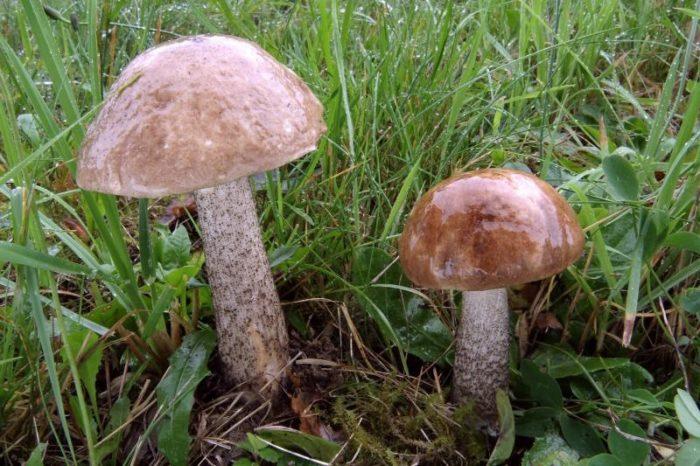
How to collect
The main harvesting season for boletus boletus begins in early August and ends in mid-September. However, the first copies can be found in July. And in mid-November, the mushroom is also found.
Where is the harsh boletus collected? As already mentioned, the fungus is quite rare, it forms mycorrhiza with poplar and aspen. At the foot of these plants, he settles.
Young mushrooms are optimal for harvesting. Although old and overgrown, they are edible, but their legs become too stiff.
It should also be borne in mind that although the harsh boletus are less likely to be affected by worms, the older the mushroom, the greater the likelihood of pests.Even at the stage of collection, it will not be superfluous to carefully examine the mushrooms and reject unsuitable and damaged ones.
In addition, it should be noted that fungi tend to accumulate all kinds of toxins and heavy metals from the soil. Therefore, for collection, you should choose an environmentally friendly place, away from industrial enterprises, roads, etc.
Main types
Common boletus (Leccinum scabrum)
Common boletus (Leccinum scabrum)
The best appearance of this group is characterized by a smooth hemispherical cap with a diameter of up to 15 cm. The peel is chestnut with a grayish, black or reddish tint, in young mushrooms it is light. The leg is up to 20 cm high, slender, wide at the base, the surface is mottled with a scaly dark pattern.
The pulp is grayish-white, then gray, does not darken at the break, at first it is hard, then soft, porous. The structure is spongy in rainy weather. Pleasant taste, mushroom aroma.
Marsh boletus (Leccinum holopus)
Marsh boletus (Leccinum holopus)
A tall mushroom with a very light, almost white convex cap, up to 15 cm in diameter. The skin is thin, sometimes greenish or brown in color. The stem is long, refined, often curved, cap color or brownish. The tubules are whitish-cream, then brownish, turn green when pressed.
The pulp is creamy, later with a yellowish-green tinge, does not darken when broken, watery, fresh in taste, with a slight mushroom aroma, often odorless.
Harsh boletus (Leccinum duriusculum)
Harsh boletus (Leccinum duriusculum)
The fleshy strong species rarely turns worm, and for this quality we are especially fond of mushroom pickers. The cap is up to 15 cm in diameter, hemispherical, then convex, concave in older specimens. The skin is velvety at first, then smooth, matte, in damp weather - slippery, light chestnut, with a red glow, often with a lilac tint. Leg up to 15 cm high, cylindrical, thickened in the center, cream-colored, covered with a reticular scaly pattern.
The tubules are creamy, and greenish-brown when touched. The pulp is tight, white-creamy, at the leg it is greenish-yellow, on the broken cap with a pink tint, when cut at the very leg it turns green or blackening. The taste is neutral, the aroma is pleasant, mushroom.
Boletus varicoloured (varicoloured boletus) (Leccinum variicolor)
Boletus varicoloured (varicoloured boletus) (Leccinum variicolor)
Externally and in culinary use, the species is similar to boletus boletus. The cap is variegated - brown with whitish-gray spots and stains, sometimes the main color is brown, almost black, reaching a diameter of 15 cm. The stem is brown, cylindrical, even, turns green at the base.
The tubular layer is off-white with a bluish tinge, darkens when pressed. The pulp is creamy white, when broken, it acquires a pink tint, at the leg - red or green. The structure is watery, the taste is fresh, the smell is light, mushroom.
Pink boletus (Leccinum roseafractum)
Pink boletus (Leccinum roseafractum)
The hemispherical cap eventually becomes cushion-shaped, reaching a diameter of 12 cm. The skin is yellowish-brown or brown, often spotted, with light streaks. The leg is low - up to 10 cm, sometimes curved, the surface is light, with a black-brown scaly pattern.
The tubes are creamy, turning pink when pressed. The pulp is tight, light creamy, turns pink when broken, later becomes dark. The smell is insignificant, the taste is simple.
Boletus gray (hornbeam) (Leccinum carpini)
Boletus gray (hornbeam) (Leccinum carpini)
Appetizing mushroom with a round cap up to 15 cm in diameter, which is hemispherical at first, then cushion-shaped, later flat. Skin color in brown-gray tones - from light gray to brown, olive, black, in the center at the edges - yellowish. The surface is velvety, first wrinkled, then matte, cracked in heat, slippery in wet weather.
The leg is high - up to 16 cm, thickened at the top, the surface is light, darkens when pressed, speckled with black scales, which later become brownish.The tubules are white, creamy gray, brown or purple when pressed.
The pulp is whitish with a yellow tone. At the break, it acquires a deep pink or red color, and later becomes black.
Black boletus (blackhead) (Leccinum melaneum)
Black boletus (blackhead) (Leccinum melaneum)
Squat appearance with a dark brown hemispherical cap, then convex, up to 10 cm in diameter. The leg is up to 12 cm high, even, brown or grayish, abundantly speckled with darker scales. The skin is velvety, then matte, in dampness - sticky.
The tubules are large, creamy or grayish-white. The pulp is tight, white, does not darken or slightly blue when broken. Mushroom aroma, neutral taste.
How to collect
The season for picking pink boletus begins in June and ends with the first frost. The first copies can be found in May. But the mass season falls on the end of August - the beginning of September.
Harvesting of pink boletus should be carried out only in damp, humid weather, since in dry times the development of mycelium stops and you can be left without mushroom trophies.
Where to collect pink boletus? The fungus grows not only on large roots and in the immediate vicinity of birch. It can often be found above young roots at a certain distance from the tree. Likes to camouflage among tall grass and moss. Prefers bright, well-lit places
Therefore, when searching, you should show attention and patience.
As the mushroom matures, undesirable changes occur in the structure of the pulp, both the cap and the legs, and its taste deteriorates. Therefore, only young specimens are suitable for collection.
How to cut a pink boletus? The mushroom is carefully cut off at the base with a sharp knife so as not to damage the mycelium. This will allow you to harvest at this place in the next season.

